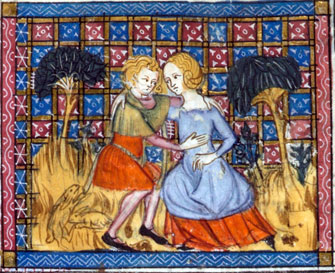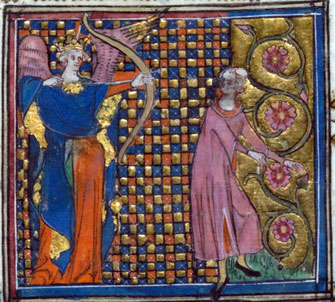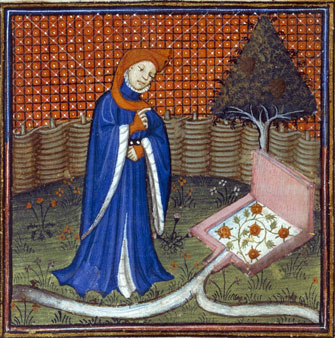For the Love of a Rose:
A Medieval Best Seller

Surrounded by cavorting rabbits, a young couple embraces in this 14th-century version of the Roman de la Rose. BNF, dept. of Manuscripts
The Roman de la Rose is probably not high on many contemporary reading lists, and, although I have always been curious to learn more about it, I have never actually done so. Now, an exhibition at the Bibliothèque de l’Arsenal in Paris, “The Art of Love in the Middle Ages: The Roman de la Rose,” offers a kind of Cliff Notes (or should I say Wikipedia) overview of the book-length medieval poem for philistines like me, with the added bonus of the display of dozens and dozens of stunning illuminated manuscripts.
As the curators explain, the 13th-century Roman de la Rose is “a long poem that deals with a timeless subject: love, its joys, pitfalls, and social and spiritual ramifications.” In an “amazingly modern” way, “it addresses questions about the art of seduction, the crudity of language, misogyny and the place of love in human life.”
For novices, a brief summary is in order, but first it is important to know that the Roman de la Rose was written by two different authors: the first part is by the poet Guillaume de Lorris, who wrote a dreamy, romantic allegory

Love’s arrow hits the Lover in the eye, from a 14th-century version of the Roman de la Rose. BNF, dept. of Manuscriptsof love that was taken up and continued some 40 years later by the Parisian clerk Jean de Meun, who added his more cynical viewpoint to the tale and gave it a more explicit sexual edge.
The story begins with that handy literary device, the dream. It is springtime. A young man, the Lover, dreams that while out walking, he comes to a walled garden. Invited in by the young female guardian, the seductress Idleness, he meets the God of Love and falls in love with the Rose, a young woman represented as a rosebud. As he tries to conquer the Rose, he undergoes various adventures and meets different characters who offer him their personal vision of love.
The story ends with the Lover achieving his goal, but not before he has defeated those enemies of love Jealousy, Shame, Fear and Danger, and has freed Bel Aceuil, the Rose’s friend, from the fortress they have locked her up in. He possesses the rose in a metaphorical love scene whose real meaning is unambiguous, with the act being justified as the perpetuation of the work of God.
Enter Jean de Meun, the second writer, who examines the ups and downs of love through such historical and literary figures as Pygmalion, Dido, Lucretia, Héloïse and Abélard; explores subjects like friendship,

The Lover sees rosebuds in Narcissus’s fountain in a 15th- century manuscript. BNF, dept. of Manuscriptsmarital discord, venality and free love; and puts a vehemently misogynous diatribe in the mouth of an old woman.
The Roman de la Rose was a best seller in its time, the most widely distributed novel between the late 13th and early 16th centuries. Some 300 copies have survived, and many of them are here, with the varied and colorful illuminations from different manuscripts illustrating the story as it progresses.
Interestingly, as the book was copied over and over again by hand, the story changed somewhat as errors were introduced, while other changes were made intentionally (removing some of the naughtier parts, for example). The exhibition also includes printed versions made in the late 15th century after the printing press became available, as well as a number of books interpreting, attacking or expanding upon the Roman de la Rose.
Eventually it lost its power to fascinate and, considered archaic, was more or less forgotten until academics began to study it in the 19th century.
Two warnings about this exhibition: all of the copious text is in French, and it is rather difficult to see the illustrations because they are small and because the light is kept very low to protect the rare manuscripts. They are still well worth seeing, however.
For those who can’t attend the show or would like to see enlargements of some illuminations, the library has created an excellent, easy-to-navigate Web site featuring many of the illustrations and recounting the story. And here you’ll find a video about and illustrations from a book showcased in the exhibition, a richly illuminated version of Evrard de Conty’s 15th-century Les Echecs Amoureux Moralisés, a commentary on the poem Les Echecs Amoureux (inspired by the Roman de la Rose) and an educational treatise for the nobility on a variety of subjects, including courtly love, chess and the gods of Antiquity.
Bibliothèque de l’Arsenal: 1, rue de Sully, 75004 Paris. Métro: Sully-Morland or Bastille. Open Tuesday-Sunday, noon-7pm. Through February 17.
Reader reaction: Click here to respond to this article (your response may be published on this page and is subject to editing).
Please support Paris Update by ordering books from Paris Update’s Amazon store at no extra cost. Click on your preferred Amazon location: U.K., France, U.S.
More reviews of Paris art shows.
© 2013 Paris Update
